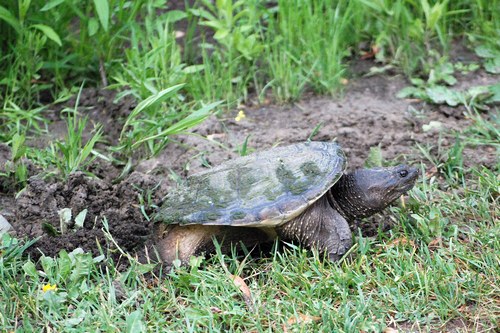Happy Snappers
Our Park residents are busy laying eggs alongside the roads where the gravel shoulders make attractive nest sites. You will notice that we protect these with wire mesh to keep out the Raccoons and other scavengers who unfortunately also like fresh eggs for breakfast.

The common snapping turtle is the largest freshwater turtle found in Canada. It can attain a shell length of up to 50 cm (19.5 in.) and weight exceeding 15 kg (33 lb.). Its serpentine neck, massive head, muscular legs, and relatively long tail make it seem even larger. It is estimated that they can live 30 to 40 years in the wild, perhaps even longer.
Snappers are generally nocturnal and consume various aquatic plants and animals, including fish, frogs, birds and small mammals. They are also scavengers, eating dead fish and drowned mammals.
Common snapping turtles are defensive if confronted on land, its neck is very flexible, and the turtle can bite if handled, even if picked up by the sides of its shell. Snappers can stretch their necks back across their own carapace and to their hind feet on either side to bite. Also, their claws are sharp and capable of inflicting lacerations.
It may be tempting to rescue a snapping turtle found in a road by getting it to bite a stick and then dragging it out of immediate danger. This action can, however, severely scrape the legs and underside of the turtle.
It is estimated that very few make it to adulthood and we can play our part in protecting them by leaving them alone and driving carefully at this time of year.


